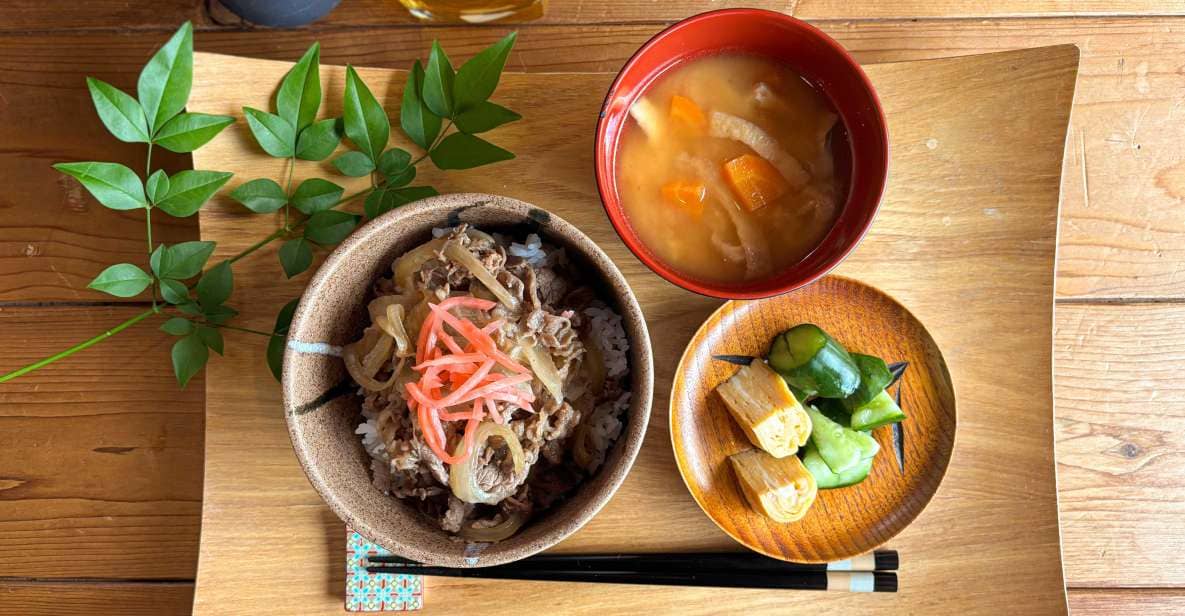As she takes her first bite of steaming hot gyudon, a wave of nostalgia washes over her. The tender beef, the savory sauce, and the fluffy Japanese rice all combine to evoke memories of family gatherings and cozy nights in. But there’s more to this beloved dish than meets the eye. Beyond its comforting flavors and aromas, gyudon holds a special place in Japanese culture, where it’s not just a meal, but a symbol of community and togetherness. And yet, there’s still so much to uncover about this ubiquitous bowl of goodness – from its rich history to its expertly balanced flavors.
Just The Basics
• Gyudon is a cultural symbol of comfort, nostalgia, and community in Japanese food culture, transcending generations and social classes.
• Essential ingredients for authentic gyudon include Wagyu beef, Japanese short-grain rice, soy sauce, onions, and scallions, which balance savory flavors and textures.
• Mastering quick searing and gentle simmering techniques is crucial for achieving tender and juicy beef in gyudon.
• Traditional side dishes in Japan, such as pickled ginger, miso soup, and tamagoyaki, provide a masterclass in balance and harmony, elevating the dining experience.
• Customizing gyudon with various toppings and seasonings, such as red pepper flakes, green onions, and furikake, allows for a personalized flavor profile.
Understanding Gyudon’s Cultural Significance
In Japan, where food is an integral part of the country’s cultural identity, Gyudon – a humble beef rice bowl dish – has evolved into an unlikely culinary icon, symbolizing comfort, nostalgia, and community.
This unassuming dish has become an integral part of Japanese food culture, transcending generations and social classes.
Gyudon’s popularity stems from its comforting, homey essence, evoking memories of childhood and family gatherings.
It’s a dish that brings people together, fostering a sense of community and social bonding.
Whether enjoyed at a bustling fast-food chain or a cozy family dinner, Gyudon embodies the heart of Japanese cuisine – simplicity, comfort, and togetherness.
Essential Ingredients for Authentic Flavor

To craft an authentic Japanese-style Beef Rice Bowl, it’s essential to start with four fundamental ingredients: premium Wagyu beef, Japanese short-grain rice, savory soy sauce, and sweet, crunchy onions.
| Ingredient | Description | Importance |
|---|---|---|
| Wagyu Beef | Rich, buttery flavor and tender texture | Provides depth of flavor |
| Japanese Rice | Plump, sticky grains absorb flavors well | Balances savory flavors |
| Soy Sauce | Savory, umami flavor enhancer | Adds depth and richness |
| Crunchy Onions | Sweet, crunchy texture and caramelized flavor | Adds contrast and sweetness |
| Fresh Scallions | Fresh, pungent flavor and crunchy texture | Adds freshness and crunch |
These ingredients harmonize to create a rich, savory, and sweet flavor profile that defines a traditional Japanese Beef Rice Bowl.
Cooking Techniques for Tender Beef
With a sizzling hot skillet as their stage, the cooking techniques employed to achieve tender beef take center stage, and it’s all about mastering the art of quick searing and gentle simmering.
A swift sear locks in juices, while a gentle simmer breaks down the connective tissues, rendering the beef tender and juicy.
The key is to achieve a nice caramelized crust on the beef, which adds a rich, savory flavor.
By cooking the beef low and slow, the collagen melts, making the meat fall-apart tender.
With these techniques, the humble beef transforms into a melt-in-your-mouth delight, elevating the humble gyudon to new heights.
Traditional Side Dishes in Japan
Alongside the savory beef, a trio of traditional Japanese side dishes – pickled ginger, miso soup, and tamagoyaki – await their turn to shine, each one carefully crafted to cut the richness of the meal and leave the palate refreshed and ready for the next bite.
These humble accompaniments are the unsung heroes of the gyudon, providing a masterclass in balance and harmony.
The tangy zip of pickled ginger slices through the richness, while the comforting warmth of miso soup soothes the soul.
Meanwhile, the sweet, fluffy tamagoyaki adds a delightful textural contrast.
Together, they create a culinary symphony that elevates the entire dining experience.
Miso Soup and Its Health Benefits
Miso soup, a staple of Japanese cuisine, has been simmering in the background, waiting to reveal its remarkable health benefits, which have been steeping in traditional wisdom for centuries.
This savory broth is more than just a comforting companion to your gyudon; it’s a nutritional powerhouse.
Rich in antioxidants, miso soup helps combat free radicals, reducing the risk of chronic diseases.
The fermented soybeans in miso also contain probiotics, supporting a healthy gut.
Plus, miso’s high protein content helps with satiety, making it an excellent addition to a weight management diet.
Pickling Vegetables the Japanese Way
In Japan, pickling vegetables, or ‘tsukemono,’ is an art form that’s been perfected over centuries, with a variety of techniques and ingredients used to create a rainbow of tangy, crunchy, and umami-rich accompaniments to balance the savory flavors of your gyudon.
To get started, you’ll need:
-
Rice vinegar: a mild, slightly sweet acid that helps to balance flavors
-
Salt: used to draw out excess water and preserve the veggies
-
Sugar: adds a touch of sweetness to balance out the tanginess
Tamagoyaki and Its Cultural Importance
Tamagoyaki, a sweet Japanese-style rolled omelette, holds a special place in Japanese cuisine and culture, symbolizing good luck, prosperity, and unity in many traditional celebrations and gatherings. This delicate treat is often served at special occasions, such as New Year’s (Oshogatsu), Girls’ Day (Hinamatsuri), and Boys’ Day (Tango no Sekku). Tamagoyaki is also a popular snack at Japanese festivals and markets.
| Occasion | Significance | Tamagoyaki’s Role |
|---|---|---|
| New Year’s (Oshogatsu) | Fresh start, good luck | Symbolizes good fortune |
| Girls’ Day (Hinamatsuri) | Celebrating girls’ health, happiness | Represents purity, innocence |
| Boys’ Day (Tango no Sekku) | Celebrating boys’ health, strength | Embodies courage, vitality |
Tamagoyaki’s significance extends beyond its delicious taste, representing the values and traditions that bring people together in Japan.
Tips for Customizing Your Gyudon Experience
To take your Gyudon to the next level, consider adding your favorite toppings or experimenting with different seasonings to create a personalized flavor profile. This is your chance to get creative and make the dish truly yours.
-
Spice it up: Add some red pepper flakes for an extra kick or try using different types of chili flakes for varying levels of heat.
-
Fresh and herby: Top your Gyudon with chopped green onions, grated daikon, or a sprinkle of toasted sesame seeds for added texture and flavor.
-
Umami bomb: Add some dried seaweed or a sprinkle of furikake to give your dish a savory, oceanic flavor.
Final Words
As the last bite of gyudon is savored, the comfort and warmth of the experience linger.
It’s more than a meal, it’s a connection to heritage, family, and community.
With its rich flavors, tender beef, and harmonious balance, gyudon is a culinary masterpiece that transcends generations.
So, go ahead, gather around the table, and share in the joy of this beloved Japanese tradition – where every bite is a celebration of togetherness.






